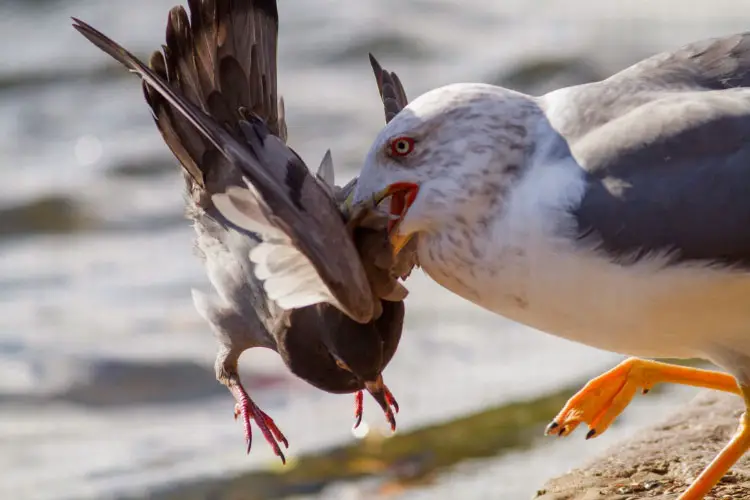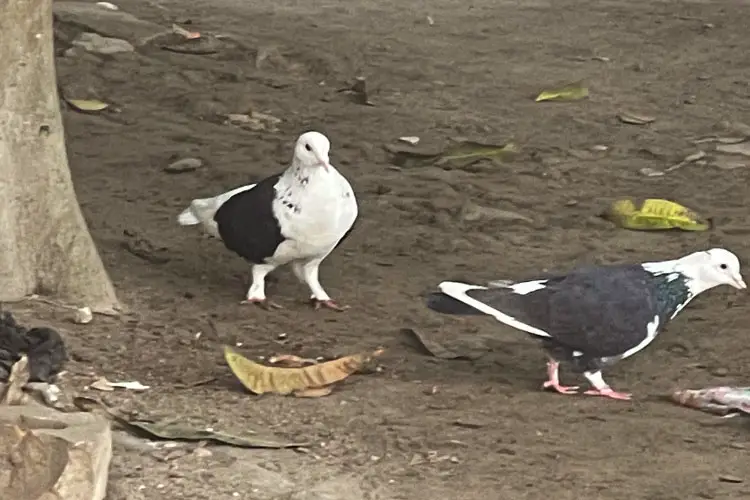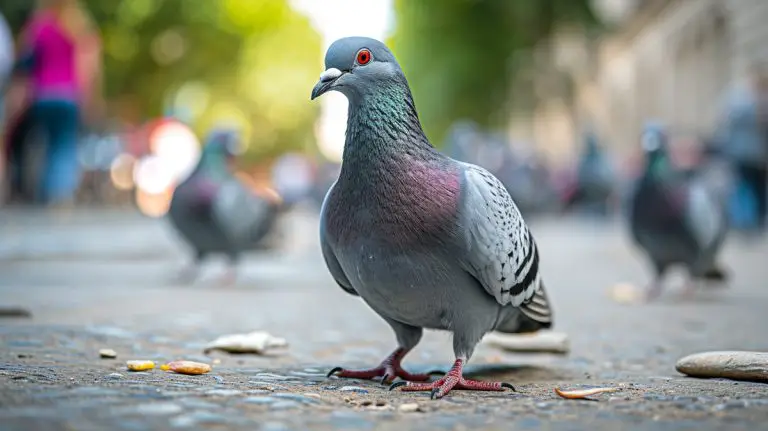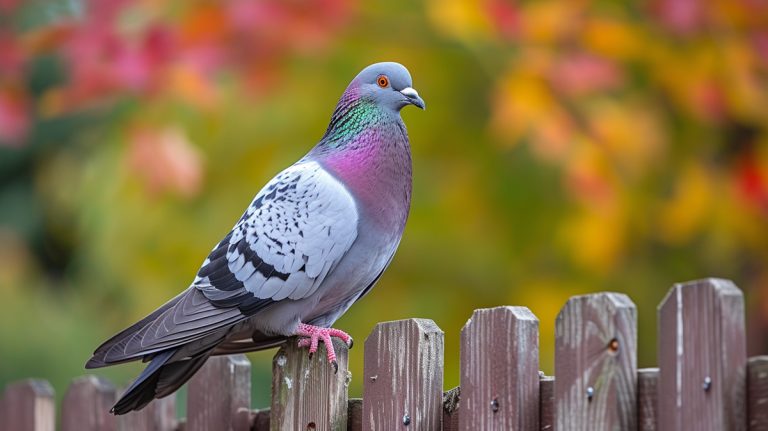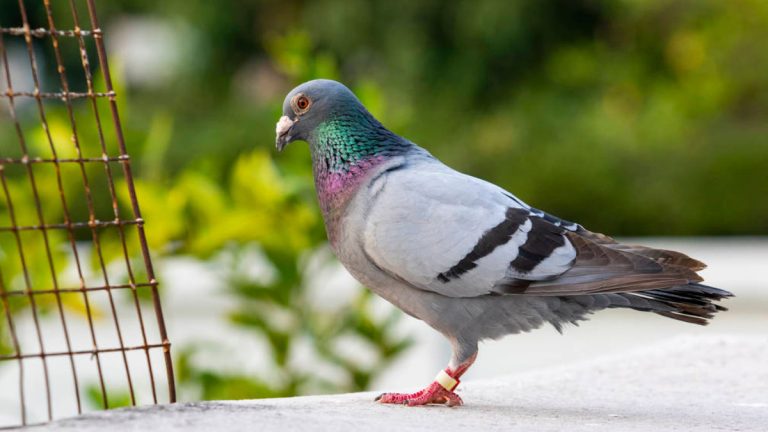Do Seagulls Eat Pigeons? The Fascinating Insight into the Feeding Habits of Seagulls
Seagulls are a common sight along coastlines and near bodies of water. Their diet list includes fish, shrimps, insects, clams, rodents, etc.
But do seagulls eat pigeons? The answer is not as simple as a yes or no. Various factors, including the availability of food, influence the feeding habits of seagulls, etc., and impact this. When there is no other source of food, they will hunt pigeons. Normally, they will not eat pigeons when other sources are available.
This article will delve deeper into the relationship between seagulls and pigeons. Keep reading to discover the surprising truth about seagulls and their dietary habits.
Do Seagulls Eat Pigeons? Here Are The Answers
Seagulls are opportunistic feeders, meaning they will eat a wide variety of food sources depending on what is available to them. If pigeons are available, they will devour them. They will eat only them where the food availability is limited and the concentration of pigeons is high.
You should note that pigeons do not make up a significant portion of a seagull’s diet, and it is not a common or regular food source for them.
By the way, see seagulls eating pigeons in the following video:
Factors That Influence Seagulls Eating Pigeons
The eating relationship between seagulls to pigeons is complex and influenced by a variety of factors, including:
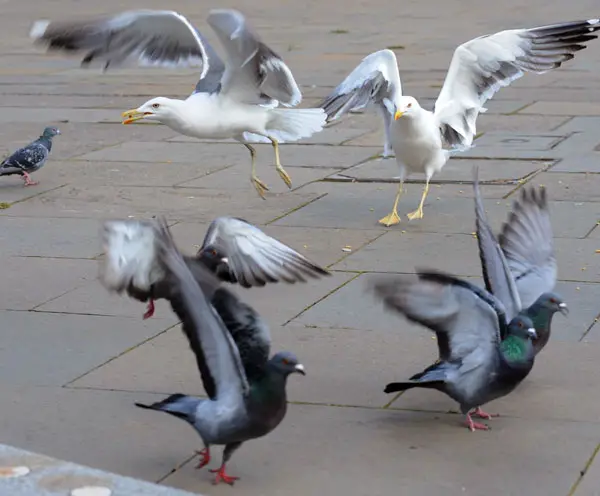
1. Availability of Food
Seagulls, like any other organism, require food to survive. Their diet is opportunistic, meaning they will eat whatever is readily available to them. If their primary food sources are scarce, seagulls may turn to other food sources, such as pigeons.
2. Human-related Factors
Urbanization and human activities can also affect the relationship between seagulls and pigeons. Urban areas are home to high concentrations of pigeons and are often characterized by limited food resources. This can lead to increased competition for food between seagulls and pigeons.
In addition, urban areas often have a high population of seagulls and pigeons. This can lead to overcrowding and competition for nesting sites and food resources. It may also increase the chances of seagulls preying on pigeons.
Another human-related factor is the presence of garbage and other human-associated waste in urban areas. Garbage can provide an easy food source for seagulls, thereby reducing their need to prey on other animals, including pigeons.
3. Seasonal Factors
Seagulls’ diet and feeding habits also vary depending on the season. For example, seagulls need to feed their chicks during the breeding season. Hence, they may need to hunt for food more frequently than usual, increasing their chances of preying on pigeons.
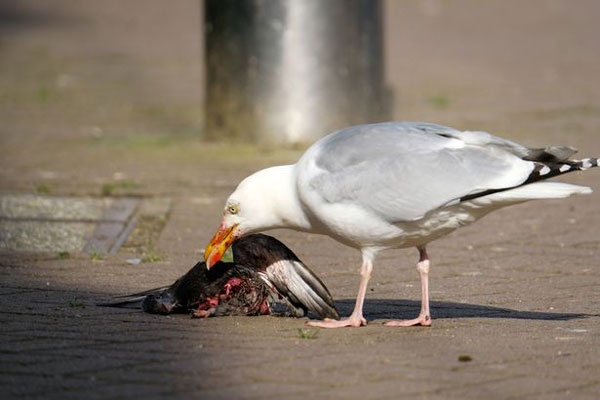
4. Competition
The presence of other bird species that prey on pigeons, such as hawks, falcons, and other gulls, can affect the likelihood of seagulls hunting pigeons. These other bird species may reduce the number of pigeons available for seagulls to hunt by preying on them themselves.
How Do Pigeons Protect Themselves From Seagulls?
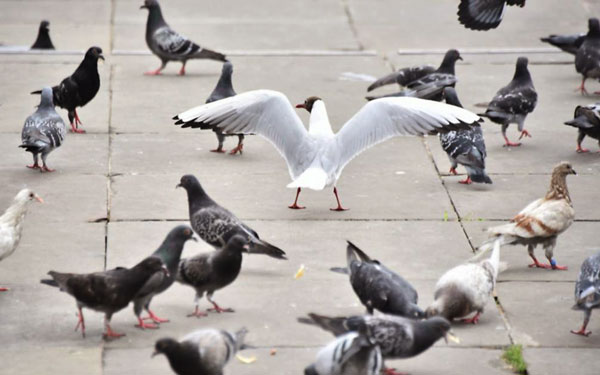
Here are a few ways that pigeons protect themselves:
1. Behavioral Adaptations
Pigeons have developed specific behaviors that help them avoid predation. For example, these birds tend to avoid open areas that are more visible to predators. They prefer to stick to areas with cover, such as buildings, bridges, and trees. Additionally, pigeons are known to be vigilant and are quick to take flight if they sense danger.
2. Physical Adaptations
These birds also have strong and rapid flight allowing them to escape from predators quickly. Their small size makes them difficult for predators to catch. They also have strong legs and sharp claws, which can be used as a defense mechanism.
3. Group Behavior
Pigeons are social animals and often flock together in large groups. This behavior provides them safety in numbers, as predators are more likely to target isolated individuals. Group behavior also allows pigeons to communicate with each other and quickly respond to potential threats.
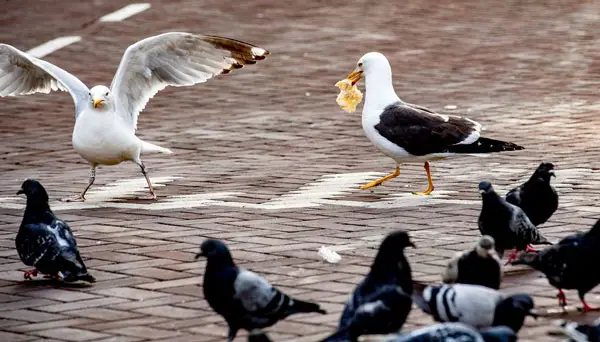
4. Habitat Choice
These small birds are particularly fond of urban areas with access to food and shelter. Urban areas can provide pigeons with a safe environment, as they have access to buildings and bridges. These structures provide them with cover and protection from predators.
What Other Things Do Seagulls Eat?
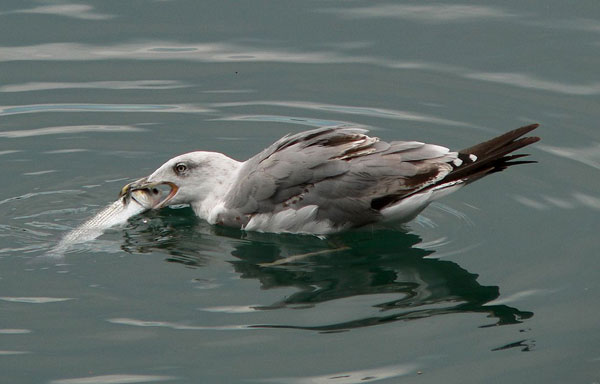
Here are some of the things that seagulls typically eat:
- Fish: Fish are a primary food source for seagulls, and they are known to feed on various fish species, including herring, anchovies, and sand eels. They are skilled hunters and can catch fish in the water and near the surface.
- Crustaceans: Seagulls feed on crustaceans such as crabs, lobsters, and shrimp. These are often found in coastal areas and estuaries, where seagulls forage for food.
- Insects: They feed on these particularly during breeding when they need to feed their chicks. Examples include beetles, grasshoppers, and ants.
- Mammals and reptiles: These predators feed on small mammals and reptiles such as mice, voles, and lizards. These food sources are less common and are usually only consumed when other food sources are scarce.
- Garbage: Seagulls are known to be scavengers and will also feed on garbage and other human-associated waste. This behavior is particularly common in urban areas, where food resources may be limited and garbage is easily accessible.
How To Protect Your Pigeons From Seagulls?
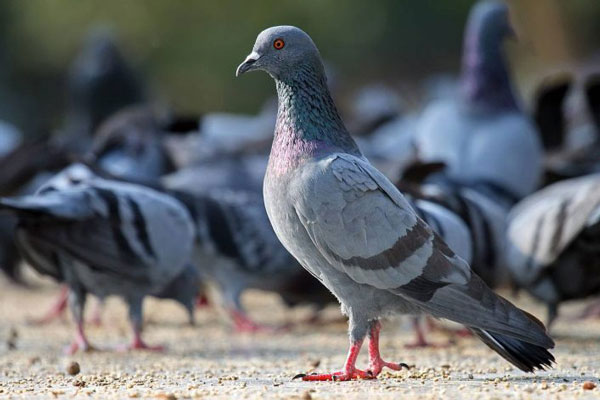
If you keep pigeons, it’s important to protect them from predators, including seagulls. Here are a few ways you can protect your pigeons from seagulls:
1. Provide Shelter
Pigeons need a safe place to roost, and providing them with a covered shelter can help protect them from predators such as seagulls. The shelter should have sturdy materials and a secure roof and walls to prevent seagulls from getting in.
2. Limit Food Sources
Seagulls are attracted to food; if you have pigeons, it’s important to limit the amount of food available. This can be done by feeding pigeons indoors or in an enclosed area. Be sure to clean up any spilled seed or food scraps to avoid attracting seagulls to the area.
3. Install Netting
Installing netting over the enclosure can also help protect your pigeons from seagulls. The netting should be sturdy and be tightly stretched over the enclosure to prevent seagulls from getting in.

4. Remove Nesting Sites
These predators are known to build nests, and if you have pigeons, it’s important to remove any potential nesting sites for seagulls. This can be done by removing old nests or debris and trimming trees or bushes that may provide a nesting site.
5. Use Noise Deterrents
Seagulls are sensitive to noise and can be deterred by loud noises. Using noise deterrents such as bird alarms, whistles, or alarms can help keep seagulls away from your pigeons.
6. Use Visual Deterrents
Seagulls are also sensitive to visual cues, and using visual deterrents such as reflective tape, shiny objects, or balloons can help keep them away from your pigeons.
If you’re interested in learning more about pigeons and their interactions with other bird species, you might find our articles on where do pigeons go in the winter and pigeon vs parrot helpful. Our article on where do pigeons go in the winter provides insights into the migratory habits of pigeons during the colder months. Meanwhile, our article on pigeon vs parrot compares and contrasts the characteristics and behaviors of these two popular bird species. Check them out to broaden your knowledge of avian biology and behavior.FAQs
Here are answers to some of the questions that might come up:
Seagulls are protected under the Migratory Bird Treaty Act (MBTA) in the United States, which makes it illegal to hunt, kill, or harm seagulls without a permit. Additionally, many states also have their own laws protecting seagulls.
However, while seagulls are protected, it may be possible to take action to control their population or protect property under certain circumstances, such as in the case of agricultural damage or public health concerns.
Seagulls are wild birds and are not suitable for domestication or training. It is illegal to keep seagulls in captivity without proper permits, and they are not suitable as pets.
These migratory birds require specific conditions to thrive, which are difficult to replicate in captivity. Furthermore, the captivity of wild animals is not recommended as it goes against their natural behavior and is considered an animal welfare violation.
Conclusion
So, now you know the answer to the question, do seagulls eat pigeons? They are opportunistic feeders, and while they are known to prey on pigeons, it is not a common or regular food source for them.
As you deal with them, remember it is illegal to harm or destroy seagulls’ nests without a permit. It’s always best to consult your local wildlife agency for guidance on handling seagulls nesting on your property. It is essential to be aware that seagulls can carry and transmit bacteria to humans, but the risk of transmission is considered to be low.
